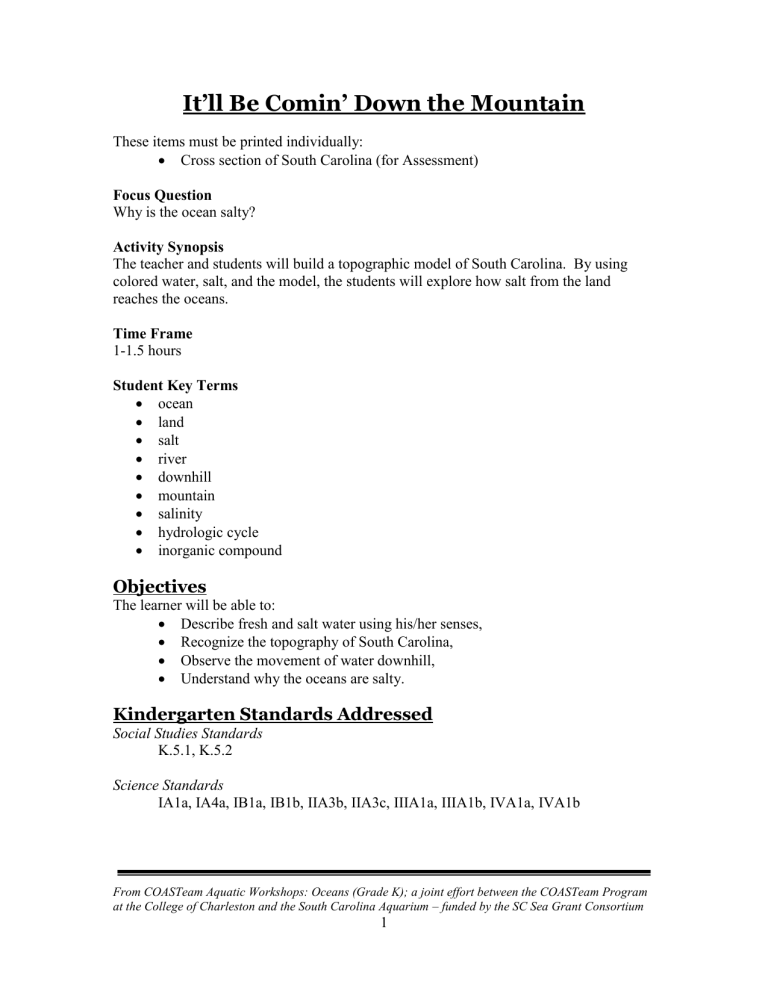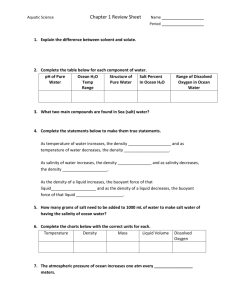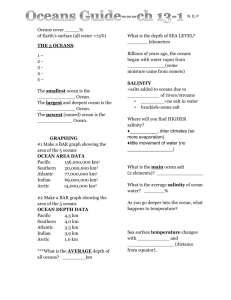It`ll Be Comin` Down the Mountain

It’ll Be Comin’ Down the Mountain
These items must be printed individually:
Cross section of South Carolina (for Assessment)
Focus Question
Why is the ocean salty?
Activity Synopsis
The teacher and students will build a topographic model of South Carolina. By using colored water, salt, and the model, the students will explore how salt from the land reaches the oceans.
Time Frame
1-1.5 hours
Student Key Terms
ocean
land
salt
river
downhill
mountain
salinity
hydrologic cycle
inorganic compound
Objectives
The learner will be able to:
Describe fresh and salt water using his/her senses,
Recognize the topography of South Carolina,
Observe the movement of water downhill,
Understand why the oceans are salty.
Kindergarten Standards Addressed
Social Studies Standards
K.5.1, K.5.2
Science Standards
IA1a, IA4a, IB1a, IB1b, IIA3b, IIA3c, IIIA1a, IIIA1b, IVA1a, IVA1b
From COASTeam Aquatic Workshops: Oceans (Grade K); a joint effort between the COASTeam Program at the College of Charleston and the South Carolina Aquarium – funded by the SC Sea Grant Consortium
1
Background
Relevant Pages in : Keener-Chavis, Paula and Leslie R. Sautter. 2002.
Of Sand and Sea:
Teachings from the Southeastern Shoreline . S.C. Sea Grant Consortium, Charleston, SC, pp. 17, 19-21.
Key Points
Key Points will give you the main information you should know to teach the activity.
The state of South Carolina has four distinct regions: the Mountains, the
Piedmont, the Coastal Plain, and the Coast. The state is bordered on the east by the Atlantic Ocean.
Freshwater rivers and streams erode and weather the rocks and soils over which they flow as the water makes its way from the mountains to the sea.
Through these processes, rivers collect inorganic salts and deposit them into the world’s oceans.
Detailed Information
Detailed Information gives more in-depth background to increase your own knowledge, in case you want to expand upon the activity or you are asked detailed questions by students.
Salinity
Information from Of Sand and Sea, by Paula Keener-Chavis and Leslie Sautter
As freshwater rivers and streams make their descent from the mountains to the sea, they slowly erode the rocks and soils over which they flow. As this happens, rocks and soils release inorganic salts and other chemical compounds into this continuous flow of water.
These inorganic salts and compounds eventually make their way into the global ocean system. Some of these salts and compounds become dissolved in the ocean water once they reach the ocean.
Ocean water is about 96.5% pure water and 3.5% naturally occurring dissolved substances. A list of the components of seawater and the % by weight follows: chloride
(55.1%), sodium (30.6%), sulfate (7.7%), magnesium (3.7%), calcium (1.2%), and potassium (1.1%).
Salinity is the term used to define the total amount of dissolved inorganic salts in the ocean. Salinity is typically measured in parts per thousand. For example, a salinity of 1 ppt (part per thousand) is equivalent to 1 gram of salt in 1000 grams of pure water.
From COASTeam Aquatic Workshops: Oceans (Grade K); a joint effort between the COASTeam Program at the College of Charleston and the South Carolina Aquarium – funded by the SC Sea Grant Consortium
2
Several different factors affect the relative amounts of dissolved inorganic salts in the ocean. Sunlight only causes the fresh water to be evaporated, thereby leaving behind only the inorganic salts. Conversely, frequent precipitation adds fresh water back into the ocean system, a process that serves to dilute the concentrations of inorganic salts in the oceans. Either changing the concentration of salts in the ocean or changing the concentration of water in the ocean can vary salinity. Areas of generally high evaporation generally have high salinities while areas of high precipitation generally have lower salinities.
The average salinity of open ocean is 35 ppt; however, salinity may range from 5ppt where rivers make their initial entrance into coastal areas, to 45 ppt in the world’s saltiest oceans. As the distance from shore increases, so does the salinity of a body of water.
Salinity has a major effect on the type and abundance of organisms in a given environment.
Interesting fac t:
Dr. Eamon O'Muineachain from Connecticut Sea Grant performed two calculations and figured out that if all of the salt were removed from the oceans spread over the entire earth, it would approximately 140 feet thick! ( http://web.mit.edu/seagrant/northeast )
South Carolina Topography
So, if you were a drop of water picking up salts and other inorganic compounds on your way to the ocean, what sights would you see on your journey through the state of South
Carolina?
The following information is from SCETV’s Circle of Inheritance, http://www.scetv.org/circle/landforms.html
In many ways, the land our ancient ancestors knew has changed very little. The natural landforms remain the same and the Palmetto State can be roughly divided into two broad areas divided by the fall line. Above the fall line, in the Upcountry, the terrain is hilly and the rivers rocky and harder to navigate. Below the fall line, in the Lowcountry, the land becomes sandier and flatter as it eases towards the sea.
South Carolina is divided into four regions: Mountains, Piedmont, Coastal Plain, and
Coast.
The Mountains (Blue Ridge) region, which makes up only 2 percent of the state's landscape, is part of the Appalachian Range. The Appalachians extend from Maine to
Georgia. The highest waterfall east of the Mississippi River, Whitewater Falls in Oconee
County, is located in this region.
From COASTeam Aquatic Workshops: Oceans (Grade K); a joint effort between the COASTeam Program at the College of Charleston and the South Carolina Aquarium – funded by the SC Sea Grant Consortium
3
The Piedmont region covers nearly one-third of the state. Rocky creeks and streams flow fast, and the mineral-rich red-clay soil was propitious for the Piedmont cotton crop during the post-Revolution era.
The Coastal Plain is separated into the Outer Coastal Plain and the Inner Coastal Plain.
The Outer Coastal Plain begins at the immediate coastal area and is between 30 and 50 miles wide. The soil in this region is dark and fertile. The region also contains black tidal rivers and swamps. During the colonial times, rice and indigo plantations flourished in the Outer Coastal Plain. The Inner Coastal Plain is between 130 and 250 feet above sea level. The area contains rich bottomlands that allowed cotton plantations to thrive after the American Revolution.
Emerging from the Atlantic Ocean, the Coastal Zone is about 185 miles long and extends
10 miles into the interior of the state. Along the shoreline is a string of barrier islands that serve to protect the coast from the storms that come in from the Atlantic. On the mainland are salt marshes and streams, both of which yield a rich abundance of seafood.
The Sandhills extend across the middle of the state. More than 50 million years ago, the coastline was located in this area. The ancient sand dunes now form the Sandhills region.
Procedures
Materials
Salt
Water
Overhead projector
Plastic spoons or coffee stirrers
Clear cups (small)
Microscopes (if not available, magnifying glasses)
A one-gallon container (to mix salt water solution for Assessment)
Newspaper
Aluminum foil
Food coloring
Spray bottle
Tray (for the topographic map)
Medicine dropper
Topographic map of South Carolina
Procedure
Session 1:
1.
Give each student a clear cup filled ¼ full of salt water.
From COASTeam Aquatic Workshops: Oceans (Grade K); a joint effort between the COASTeam Program at the College of Charleston and the South Carolina Aquarium – funded by the SC Sea Grant Consortium
4
2.
Ask the students “What is in your cup? How could you use your sense to find out what is in the cup?”
3.
Lead a class discussion on how the students used their sense to determine that the solution is salt water.
4.
Ask the students “If we remove the water, what will remain?”
5.
Spread several drops of the salt water solution onto an overhead transparency and allow the water to evaporate. This should take 15-20 minutes. If possible, evaporate one drop per student.
6.
Ask the students what they see on the transparency. Allow the students to taste the salt.
7.
Give each group (2-3) of students a sample of salt. Prompt the students to describe the salt with their senses. How does it feel between your fingers? How does it taste? Does it smell?
8.
Tell the students “Now we will use our sense of sight to describe the salt.”
Discuss the physical characteristics that can be observed with the naked eye – color, grain size, etc. Have the students observe salt under a microscope. Lead a class discussion about their observations. Have each student draw what he/she sees under the microscope.
9.
Give each student a cup filled ¼ full of fresh water. Prompt the students to use their sense to describe what is in the cup. How is it different than the first cup of water? How is it the same? The students can create a Venn diagram for this purpose.
10.
Ask the students “How could we make saltwater?”
11.
After the students determine that they should add salt to the fresh water, give each student a plastic spoon or coffee stirrer and more salt. Allow the students to dissolve the salt in the fresh water.
12.
Have the students taste the new solution! This prompts the student to understand that the solution gets saltier with the increasing number of rocks included.
Session 2:
1.
Make a salt-water solution tinted with blue food coloring prior to class. Make a topographic model of South Carolina with the students, or prior to the beginning of the activity.
2.
How to make a topographic map: Crumple newspaper into small balls and tape them down in the tray so that you model the topography of South Carolina. Place aluminum foil or plastic wrap over the newspaper so it follows the contours of the crumpled up newspaper to simulate the topography of the mountains to the coast. If you need more elevation, place a book under one end of the tray to simulate the sloping of land toward the sea. You may want to create a “river” in the center of the topographic map by denting the aluminum foil. Also, be sure to have a large enough depression at the bottom of the topographic map so that the salt water collects and creates the Atlantic Ocean!
3.
Ask the students: “Has anyone ever been knocked over by a wave in the ocean? Did you accidentally swallow some ocean water? Did it taste like the water you drink
From COASTeam Aquatic Workshops: Oceans (Grade K); a joint effort between the COASTeam Program at the College of Charleston and the South Carolina Aquarium – funded by the SC Sea Grant Consortium
5
from your kitchen? Did it taste like the water we just made? How do you think that salt gets into the oceans?”
4.
Remind the students how they discovered the downhill movement of water in the previous activity, Water Wonders. Also, ask the students if they recall the journey of a raindrop across the state of South Carolina. Has anyone visited the mountains? Did you have to drive a long time to get there? Do we have mountains outside of our school? Lead the students to conclude that a mountain is a giant hill.
5.
Have the students compare the topographic model to an actual topographic map of
South Carolina. Point out the mountains and the flat coastal area.
6.
Ask the students: “How would water get to the top of a mountain?” (rainfall)
“Where would the rain go once it falls onto the mountain?” Explain to the students that as rivers flow over rocks and soil, that little bits of the rock are worn away. Salts are located in the rocks, so the water in rivers picks up the salts and carries them to the oceans.
7.
Sprinkle salt over the topographic map. Allow the students to taste the water prior to its journey across the map! Have the students describe the water using their senses.
Why is the water blue?
8.
Ask the students: “How will we model rainfall on top of the mountains?” Have students spray several pumps of water on the model (for management purposes, you may want to do the spraying yourself). Students will observe how the water flows downhill.
9.
Ask the students “Do you still see the salt?” “Where did it go?” Lead the students to determine that the puddle at the base of the map represents the Atlantic Ocean.
10.
Using the medicine dropper, collect the water from the “Atlantic Ocean” and drop a sample into each student’s mouth.
11.
Prompt the students to describe how the water now tastes. Why is the water now salty? What does this tell you about the salty ocean water?
Assessment
Session 1:
Give the student a cup of salt water and have him identify what is in the cup using sensory descriptors.
From COASTeam Aquatic Workshops: Oceans (Grade K); a joint effort between the COASTeam Program at the College of Charleston and the South Carolina Aquarium – funded by the SC Sea Grant Consortium
6
Mastery/Nonmastery : The student knows the correct sense(s) in order to identify the liquid.
Session 2:
Using the cross-section of South Carolina provided with this packet, have each student look at the picture and tell the story of a raindrop traveling across the state. Ask the student “what kind of water is in the ocean” and have them use the picture to explain how salt gets to the ocean. Alternatively, the students can draw their own cross-section to use.
Mastery/Nonmastery: (Story beginning) Student knows that water flows downhill. (Story middle) Student knows that raindrops carry salt from mountains down the river to the ocean, and (Story end) that the ocean contains salt water.
Members of the COASTeam Aquatic Workshops development team include: Katrina
Bryan, Jennifer Jolly Clair, Stacia Fletcher, Kevin Kurtz, Carmelina Livingston, and
Stephen Schabel
From COASTeam Aquatic Workshops: Oceans (Grade K); a joint effort between the COASTeam Program at the College of Charleston and the South Carolina Aquarium – funded by the SC Sea Grant Consortium
7
Mastery/Nonmastery: The student knows the correct sense(s) to use in order to identify the liquid.
Mastery/Nonmastery: The student knows the correct sense(s) to use in order to identify the liquid.
Session 2:
Using the cross-section of South Carolina provided with this packet, have each student look at the picture and tell the story of a raindrop traveling across the state. Ask the student “what kind of water is in the ocean” and have them use the picture to explain how salt gets to the ocean. Alternatively, the students can draw their own.
Mastery/Nonmastery : (story beginning) Student knows that water flows downhill).
(story middle) Student knows that raindrops carry salt from mountains down the river to the ocean), and (story end) that the ocean contains salt water.
From COASTeam Aquatic Workshops: Oceans (Grade K); a joint effort between the COASTeam Program at the College of Charleston and the South Carolina Aquarium – funded by the SC Sea Grant Consortium
8







